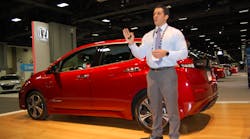So I spent some time at the 2018 Washington Auto Show, reviewing a whole host of light-duty vehicles – everything from pickup trucks and cargo vans to sports cars, with a few “classics” interspersed in there for good measure.
Two in particular caught my eye: the latest iteration of the Nissan Leaf all-electric battery-powered sedan and the experimental FCR (short for “Fine Comfort Ride”) fuel cell-fired prototype built by Toyota.
So why should truckers care about these small vehicles; ones that can’t haul a decent of load of freight?
For starters, they serve as platforms for further research and development on electric propulsion systems – R&D aimed at not only creating batteries that can store and deliver more juice (thus boosting range) but that can be recharged faster as well.
For example, Brian Maragno, director of marketing and sales strategy or electric vehicle (EV) operations at Nissan North America, noted that the latest iteration of the Leaf can now be recharged to 69% of its potential range (88 miles) in less than 30 minutes, with 80% of its potential range (105 miles) attainable after 40 minutes of recharging.
The Leaf – now sports 147 hp and 236 ft.-lbs. or torque, 37% and 26% higher, respectively, than the previous model – also comes with both 120 volt and 240 volt recharging “hardware” now so the Leaf can “refuel” just about anywhere.
Maragno noted that demand for EVs is climbing. In 2010, he noted only two EVs were commercially available – one of them being the Leaf. By this year, some 18 EV models will be available. But by 2023, he said 37 EV models will be on the market – a steep ramp up in offerings.
Over at Toyota, Tom Stricker, vice president of product regulatory affairs, pointed to the use of fuel cells to provide electric power – as well as the development of prototypes like the FCR to highlight the possibilities of hydrogen-fired fuel cells not just for cars but for heavy trucks as well.
“Our mission at Toyota is to create better ways to move,” he explained. “We’re bullish on fuel cells because they provide a ‘mobility’ experience similar to what people get today. The range [of the FCR] is over 300 miles and it takes less than five minutes to refuel its hydrogen tanks.”
That’s very comparable to today’s diesel and gasoline refueling times, Stricker said.
He added that Toyota envisions a big market for EVs and plans to sell 5.5 million of them per year by 2030 and with one million of those 5.5 million so-called “zero-emission” vehicles or ZEVs – the ones most likely powered by fuel cells.
“We’re not hitching our wagon to just one electric technology – we’re looking at hybrids, plug-ins, battery-electric, and fuel cell propulsion,” Stircker explained.
Some of that vision is starting to come to life in California, according to a report entitled The Road Ahead for Zero-Emission Vehicles in California: Market Trends & Policy Analysis generated by Beacon Economics for the Next 10 think tank.
Right now California is on track to be home to 1.5 million ZEVs by 2030, but the report stressed that the Golden State needs a recharging network to keep up with “refueling” demand for those vehicles.
“2017 marked a turning point for electric vehicles. Battery costs fell, ranges grew, new models hit the showrooms, and nations including China, France and the U.K. announced plans to phase out gas-powered cars,” noted F. Noel Perry, businessman and founder of Next 10, in the report. “The growth we’re seeing in California’s ZEV market shows that the state is standing alongside leading countries in the transition to a cleaner transportation future.”
As of October 2017, some 337,483 ZEVs have been sold in California, with ZEV sales increased 29.1% between 2016 and 2017, bringing the Golden State’s ZEV market share to 4.5%, compared to 3.6% in 2016. ZEV adoption isn’t just accelerating in California, the report noted. In 2017, global passenger electric vehicle sales reached about one million, up from half a million in 2015. Looking ahead, the report finds that electric vehicles could be as ubiquitous in 2040 as smartphones are today.
“Often with advanced technology, adoption hits a tipping point and then you see exponential growth – an ‘S-curve’ – rather than incremental, linear rates of adoption. And ZEVs are following this pattern,” noted Adam Fowler, an economist at Beacon. “Add to that the advent of autonomous vehicles and new business models such as ride hailing and car sharing, and we could be on the brink of major disruption in the transportation sector.”
The key will be ensuring that California’s recharging infrastructure keeps up with EV sales growth. Currently, the Golden State has 16,549 public and non-residential private-sector recharging outlets — the most in the U.S. by far, Beacon said.
But that works out to only 0.05 public charging outlets per California ZEV, and that’s one of the lowest ratios in the country and other studies show that California will need 125,000 to 220,000 charging ports from private and public sources by 2020 in order to provide adequate infrastructure.
And that recharging network will be critical to powering the electrified Class 8 commercial trucks now in development, such as Thor’s ET-One and Tesla’s Semi tractor. We’ll see how this race to electrification progresses.



